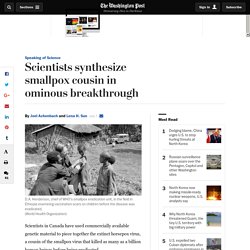

Something Very Disturbing Happens To Bacteria In Space. Astronauts on long-term missions might have to face off many dangers and some of those might be coming from Earth.

A new study on the adaptability of bacteria in space has shown that they can fight off antibiotics better because they change shape. An international team of researchers sent cultures of E. Coli to the International Space Station to be treated with different concentrations of gentamicin sulfate, an antibiotic that easily kills the bacteria on Earth. The team discovered at the end of the experiment there were 13 times more E. Coli in the space cultures compared to the Earth-bound control sample and the cell size was 63 percent smaller. “We knew bacteria behave differently in space and that it takes higher concentrations of antibiotics to kill them,” lead author Luis Zea, from the University of Colorado Boulder, said in a statement.
Without gravity, there’s no longer buoyancy and sedimentation, which helps bacteria reach nutrients. Scientists synthesize smallpox cousin in ominous breakthrough. D.A.

Controversial Study Created Airborne Virus Similar To 1918 Pandemic Influenza Virus. In order to assess the risk of this happening, an international team of researchers headed by Yoshihiro Kawaoka of the University of Wisconsin-Madison first searched online databases in order to find out if any close relatives to the 1918 viral proteins exist in current the avian influenza virus pool.

They identified eight genes which produced proteins that were highly similar to proteins produced by the 1918 virus. The Next Bioweapon May be a Text File - Wired Science. An influenza virus (orthomyxoviridae) seen via electronic microscope.

(Image: Flickr/Sanofi Pasteur) In 2011, at a meeting in Malta, Dutch scientist Ron Fouchier announced that he had created a particularly dangerous strain of the H5N1 flu virus using the tools of synthetic biology. Unlike all previously known versions of H5N1 – known colloquially as the “bird flu” – this variant could be spread through the air between people, potentially leading to a global pandemic. Researchers May Have Created A H1N1 Flu Strain Capable Of Evading The Immune System. Back in June, we heard of a controversial study conducted by a team of University of Wisconsin-Madison researchers that generated an influenza virus with similar characteristics to the infamous 1918 pandemic flu virus.

The research was criticized by many and branded as crazy, foolish and dangerous by experts. Now, according to The Independent, lead researcher Yoshihoro Kawaoka has gone one step further by manipulating the 2009 H1N1 flu strain so that it can evade the immune system. The 2009 influenza A H1N1, or swine flu, pandemic is estimated to have resulted in between 151,700 and 575,400 deaths within the first year that the virus circulated. 5 Diseases You Should Be More Afraid Of Than Ebola. The current outbreak of Ebola virus disease (EVD) in West Africa is the largest in history, and has already killed over 1200 people.

Those living in more developed areas have become fairly sheltered from the devastating effects of widespread infectious disease over the last 60 years or so, due to widespread availability of vaccines, competent healthcare, and education about hygiene’s role in disease transmission. Ebola is particularly unlikely to cause a pandemic in the developed world, as the method of transmission requires close contact with infected people. However, that doesn’t mean that it’s completely impossible for diseases to become widespread in more developed areas. Check out these 5 diseases that could easily cause a global health emergency: Influenza Around 3-5 million people around the world will become severely ill due to the flu virus every year, resulting in 250,000-300,000 deaths.
H7N9 is particularly troubling, because we don’t know that much about it. Researchers Discover How Deadly Rabies Virus Hijacks And Manipulates Nerve Cells. For the first time, researchers have managed to successfully trace how the deadly rabies virus traverses considerable distances through nerve cells before ending up in the central nervous system (CNS), where it begins to exert its fatal effects.

They found that the virus not only hijacks transport machinery that serves to keep the cell healthy and functional, but it actually manipulates this system in such a way that it cranks up its speed, thus facilitating its own efficient delivery to the CNS. The work has been published in PLOS Pathogens. Rabies is a vaccine-preventable disease that affects over 150 countries and territories worldwide, resulting in some 55,000 deaths each year.
Arrête de recherche américain sur virales Super souches, invoquant des préoccupations de sécurité. Last week, the White House Office of Science and Technology Policy stunned scientists when it announced a moratorium of federally-funded research of enhanced viral strains of influenza, SARS, and MERS.

The decision came about following a series of public safety concerns, should these souped-up viruses escape from the lab. During this time, no new federal grants will be given for this type of research, and existing projects have been asked to suspend their work. The policy is expected to remain in place while the White House deliberates with the National Science Advisory Board for Biosecurity (NSABB) and the National Research Council (NRC) of the National Academies to discuss how this type of research should proceed. The recommendations are expected to be revealed sometime in 2015. These studies take viral strains and give them properties they wouldn’t otherwise have, in what is called a “gain of function” (GOF). Deliberations with NSABB began on Wednesday (October 22).
St. Confronting Biological Plagues like Ebola, Smallpox, and Anthrax. Coronavirus. Un article de Wikipédia, l'encyclopédie libre.

Cet article concerne Coronavirus. Pour Coronavirus MERS-CoV, voir MERS-CoV. Réplication[modifier | modifier le code] 1. Grâce à leur protéine S, les virus à couronne se lient aux molécules cellulaires de surface telles que les métalloprotéinases.